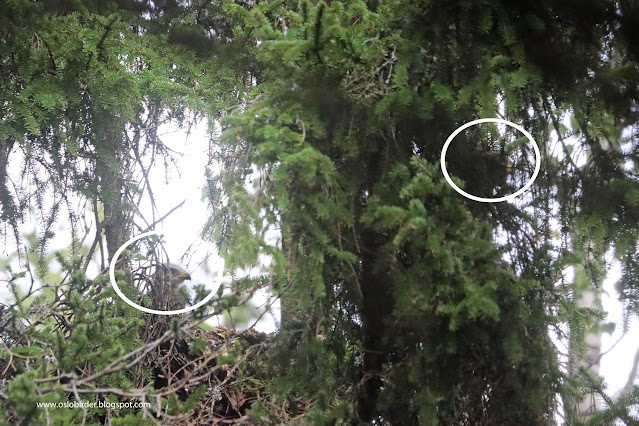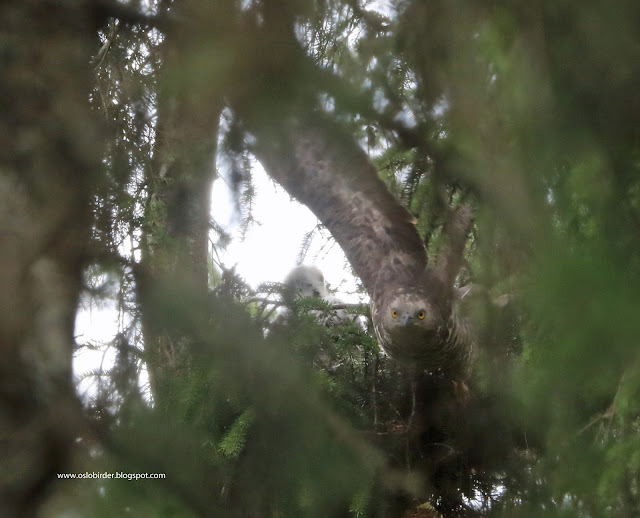In 2021 as detailed in this post I was lucky enough to be shown a Honey Buzzard nest that Stig Johan Kalvatn found. Last year we found no breeding pair in what generally seemed to be a bad year...
In 2021 as detailed in this post I was lucky enough to be
shown a Honey Buzzard nest that Stig Johan Kalvatn found. Last year we found no
breeding pair in what generally seemed to be a bad year for the species
although what looked to be the 2021 male was seen a few times in the area. This
year though a good team effort discovered a new nest and new pair only 1.4km
away.
On 8 June Stig had the first sighting of the year in the area with a male. This was not the same as the bird from 2021 but turned out to
be this year’s breeding male. On 12 June I visited the area and had a pair
flying together which I have already posted some pictures of including this one:
 |
| this year's pair on 12 June. The male at the top can be seen to be slightly smaller with narrower wings as well as the plumage differences. Note how his wing tips seem to be dipped in ink |
On 15 June I saw
the male arguing with a Common Buzzard but after this we had no sightings of
note and did not search in July. On 2 and 3 August I had sightings in Maridalen
of Honey Buzzards coming and going from the general area of the distant 2021
nest and this prompted me to visit a closer viewpoint on the 4th. I
had 7 sightings in total of HB and most interesting was a distant bird that
chased away a Raven flying low over the forest before returning to where it had
appeared and sitting in a tree top seemingly calling (I was too far away to
hear the call but through the telescope it looked to be).
Stig visited the area I had pinpointed on 9 August and had
an adult female alarm calling but could not locate the nest. I was spurred into
action and visited the area the next day and also experienced the female alarm
calling. As I walked through the forest she would change her position and it
was easy to conclude the rough area where the nest had to be but none the less
it was not easy to find. I had actually given up and was leaving the area when
one final look upwards revealed a dark lump towards the top of a spruce tree. It
was difficult to get a good view of the “lump” in the dense forest but I was
eventually certain that this was the nest despite not seeing either an adult or
young bird on it.
 |
| the female Honey Buzzard (vepsevåk) |
 |
| the nest |
I visited again the next day (11th) with Stig and
we found a watchpoint that gave us an extremely narrow view of the nest. We
could see there were two small downy young with a noticeable size difference
between them. The female was not sitting by the nest, and nor did we hear her
alarm calling at our presence so the young had obviously reached a size when
she was now prepared to leave them alone. However, and most excitingly, the
male came with food, a frog, and for 25 minutes he fed them by tearing off tiny
strips of flesh and putting these in their bills. After the food was finished
he then spent 10 minutes standing on the nest preening unaware, or unconcerned,
by our presence.
 |
| the male at the nest with one young visible |
 |
| both young visible |
 |
| the male in flight |
I then visited the nest quite regularly and made notes and
tried to document as much as I could. On 18 August I saw food delivered twice
to the nest and the young fed themselves.
 |
| the two young |
 |
| the older (larger) young is losing some of its downy feathers |
 |
| the female delivering food |
On 22 August though the young were fed by the male. I
suspect that when the food was wasp nest then the young could feed themselves
but when it was meat (mostly frogs?) then the young still needed feeding. It
was never easy to see what the the adults were bringing to the nest although
there was very few remains from wasps nest to be found under the nest at the
end of the season (significantly less than under the 2021 nest and each piece
quite small).
The female was last seen with certainty (and documented) on
the 18th although I believe she was still present on 22nd.
 |
| the young on 28th August still with a noticeable difference in size and development |
By 31st August the oldest young was perching on
branches by nest and flapping wings.
 |
| the two young |
 |
| I discovered vantage point on the other side of the nest. I was closer but had a worse angle but this was where I would observe for the next 2 weeks |
 |
| the older young is now perching away from the nest |
n 1st September young were being fed at 30 minute
intervals suggesting the male had found a wasps nest quite close by. A very
interesting thing happened when two birds started calling close to nest. It turned
out to be the and a young bird. Both
then flew around calling but the young was not from the nest and must
have been a fledged young from somewhere else!
 |
| the adult male calling |
 |
| and the visiting juvenile. A dark bird |
 |
| adult M left and juv right |
 |
| the translucent patches in the wings are quite a good ID feature |
4th September. For the first time it was clear that the male was aware of my presence and he called as he flew away from the nest but this did not stop him visiting regularly
 |
| the male calling whilst keeping an eye on me |
 |
| the oldest young |
 |
| dad and a Sparrowhawk (spurvehauk) |
7th September was the first time I saw the oldest
youngster fly and both young were also for first time perched on branch by nest. The oldest bird is a fairly dark bird but not as evenly dark as the intruding juvenile pictured on 1 September whilst the youngest is much paler.
 |
| both young. The youngest bird (left) is much paler on the underside and still has a bit of down on the head |
 |
| the youngest juvenile |
12th September, the youngest juvenile was able to
fly and the other juv could be heard calling but distantly. The male was seen
to fly in with food when I was on my way to nest but I did not witness food
delivery when I was at nest.
 |
| the older, darker juvenile |
 |
| and the younger, paler one who has suddenly become an accomplished flier |
 |
| dad watched from afar as he flies over nest |
13th September, I was at nest for 5 and a half
hours and only saw youngest young around nest and no adult.
14th September on my way to nest the youngest
bird flew up from ground 150m south of nest and disappeared – this was to be last
sighting.
A lot of my documentation was in the form of video and I still have to go through these properly but here is a short video made up mostly of clips that I had published on Twitter.
This year’s nest was a late nest by any measure. In 2021 the
single youngster left the nest on 31 August and this year I had a fledged youngster
from another nest over this nest on 1st September plus had seen
another fledged youngster flying around at Nordre Øyeren on 30 August. So why
would they be around 2 weeks behind “normal” yet still manage to raise 2 young?
They were a new pair for the area and therefore quite possibly first time
breeders. I saw them flying together on 12 June and this was before they had
settled down to breed so if they met late and had to build a new nest from
scratch then this would explain a late start to breeding and therefore late
fledging. Mid September is pushing things for the young to set off on their own
as weather can start being cold and wet and therefore their chances of finding
food on their own dimmish. With stated nest building times of 10-15 days,
incubation 30-35 days and fledging 40-44 days then nest building will have
started around the time I saw the pair and egg laying at the end of June. But
how did they raise two young especially as the female seemed to disappear over 3
weeks before fledging? Well, the male seemed to be very good at providing food
and that was despite there not appearing to be evidence of an abundance of wasp
nests but he was able to find frogs.
View Entire Post





























































